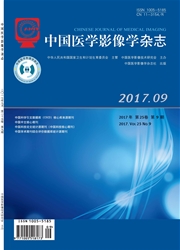

 中文摘要:
中文摘要:
目的探讨动态增强磁共振成像(DCE-MRI)在肺癌脊柱转移判别诊断中的应用价值。资料与方法对61例脊柱转移癌患者行DCE-MRI,对扫描获得的图像进行后处理,获得信号强度-时间曲线、曲线上升期信号强度增幅(Peak SE%)、曲线最大上升线性斜率(Max Wash-in SE%)、曲线下降斜率(Wash-out SE%)等半定量参数,应用双室药物代谢动力学分析获得容积转运常数(Ktrans)和速率常数(Kep)等定量参数。应用CHAID法建立决策树模型,确定最佳分类参数,并识别最优分割。结果 61例脊柱转移癌患者的DCE-MRI扫描参数中Wash-out SE%、Kep在肺癌与其他肿瘤脊柱转移之间差异有统计学意义(P〈0.01),而Peak SE%、Max Wash-in SE%、K~(trans)在两者之间差异无统计学意义(P〉0.05);当Wash-out SE%〉-660.6%且Max Wash-in SE%〉98.0%时约94.7%的患者原发灶可能来源于肺;使用本研究建立的决策树进行判别时,10-折交叉验证显示其错误率为(29.5±5.8)%。结论采用DCE-MRI半定量及定量分析参数进行肺癌脊柱转移的判别诊断具有可行性,可以为脊柱转移癌的来源鉴别及临床治疗提供参考依据。
 英文摘要:
英文摘要:
Purpose To explore the application value of dynamic contrast enhanced MRI(DCE-MRI) in judging and diagnosing metastasis of lung cancer. Material and Methods Sixty-one metastatic spinal tumor patients received DCE-MRI and their images acquired after scanning were post-processed. Signal intensity-time curve, signal intensity amplification in rising period of the curve(Peak SE%), maximum ascending linear slope of the curve(Max Wash-in SE%) and descending slope of the curve(Wash-out SE%) and other semiquantitative parameters were acquired. Double chamber pharmacokinetics was adopted to analyze and obtain Ktrans, rate constant(Kep) and other quantitative parameters. CHAID method was taken to establish tree structure model to confirm optimal sorting parameter and identify optimal division. Results For the DCE-MRI scanning parameters for 61 metastatic spinal tumor patients, differences of Wash-out SE% and Kep between lung cancer and other tumor spinal metastasis were statistically significant(P〈0.01), while differences of Peak SE%, Max Wash-in SE% and K~(trans) between the two were not statistically significant(P〈0.05). When Wash-out SE%-660.6% and Max Wash-in SE%98.0%, original focus of about 94.7% was possible to come from lung. When taking tree structure model set up in the study for identification, 10-fold cross-validation indicated(29.5±5.8)% error rate. Conclusion Taking DCE-MRI semi-quantitative and quantitative analysis parameters for identification and diagnosis of metastasis of lung cancer is feasible. It can provide reference evidence for source identification of spinal sarcoma and clinical treatment.
 同期刊论文项目
同期刊论文项目
 同项目期刊论文
同项目期刊论文
 期刊信息
期刊信息
